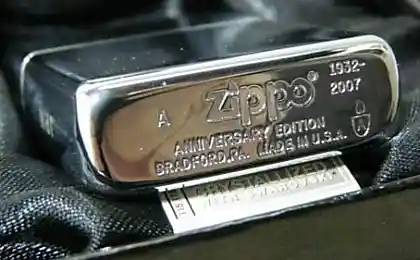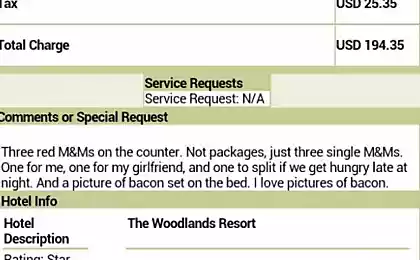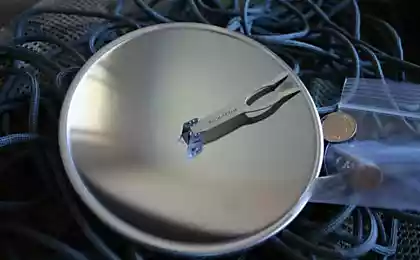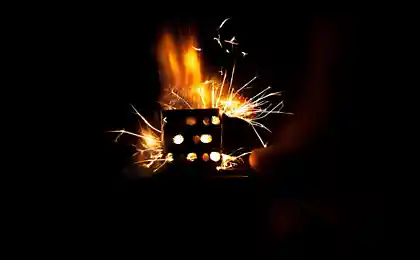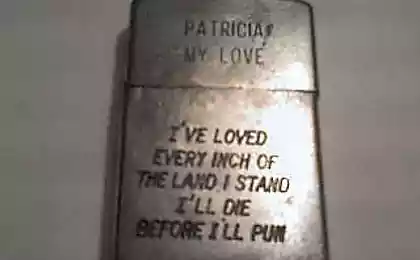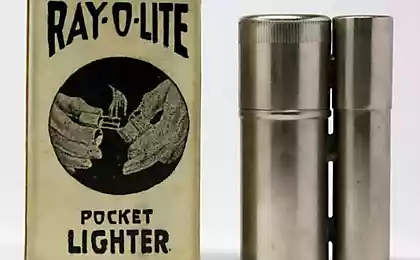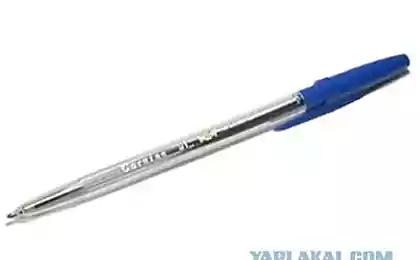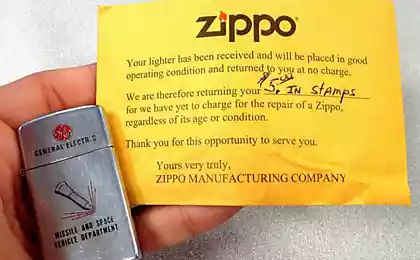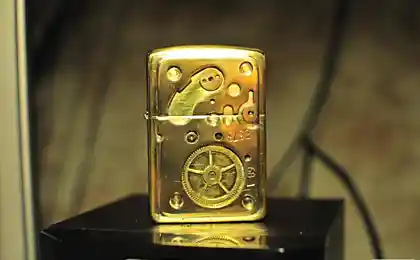1607
It created a Zippo lighter
Back in 1932 during the "Great Depression" in the distant (from us) America in Pennsylvania in the town of Bradford oil in an ordinary village club dancing someone came George Bleysdell. He was co-owner of a small company for the production of a simple oil-producing equipment.
From his youth he had an affair with metal and machinery and has a great desire to invent. Dancing and empty talk about politics soon tired of George, and he went out to smoke on the porch of the club, where he found his friend Dick Dresser, puffing in an attempt to remove the cover with his old and battered Austrian lighter. Dick was quite a wealthy man, and George allowed himself to remark: "Why do not you buy more presentable lighter?" Dick finally pulled off the lid and struck a wheel. Despite the relatively strong wind, lighter lit, and Dick lit his cigarette. "Because it works!" - Dick grunted in response to the question, George. At this point, George thought occurred: "Lighter! Here's what you need to constantly person regardless of his material situation! "Since then, the head of George was filled with the idea of producing reliable lighters accessible to everyone.
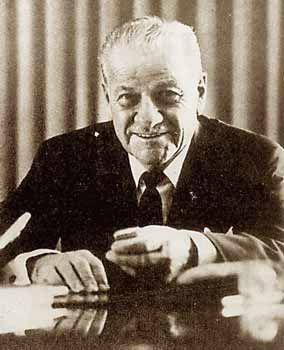
He began by saying that he had received an exclusive license to import Austrian lighters in the US and bought a small lot for sale. Unable to sell any, he found some defects in them and decided to create his unfading lighter. Rent a small room in the building metalloremontnyh workshops, he filled his second-hand machines, hired three locksmiths, and work has begun to boil.

First Bleysdell reduce the size of the lighter so that it fits in your palm. He then, remembering the suffering of others, Dick, combined with the housing cover loop. Now you can open and zapalivat lighter in one hand. Windscreen around the wick he left unchanged, keeping even the same number of holes, was found in the Austrian ancestor. Slightly improved wheel and flint. Petrol was poured directly into the body, which is of a simple brass became chrome.
So, the new product was ready. He received the name «Zippo». Origin of the name is also very uncomplicated. Around the same time, the US was invented solid sliding metal clasp, we have received the name "Lightning", and at home - "Zipper". Bleysdellu liked the sound of the word "zipper" and he decided to call his work in tune with him.
The price of the new "windproof" lighters was $ 1.95. In the first month it sold 82 pieces. The case has gone. Reliability, convenience and affordable price Zippo quickly won her popularity, but still a major advantage Zippo was trading company policy, as expressed in almost perpetual guarantee of its products. Engineer Bleysdell so loved his child that swore that looks Zippo not be replaced while he lived.
But after his death Lighter virtually retained their form. However, some models have become more refined, richer and more colorful. But the highest reliability, achieved already at the beginning, remained unchanged. No wonder the museum in Bradford Zippo lighters are kept of all time, since the release of 1932. And all the work!
Continuing the theme of the history of the world-famous cigarette lighters, you can not miss the story of advertising talent of their creator - "Mr. Zippo", namely the so began to call an engineer Bleysdella already since the release of the first batch of lighters.
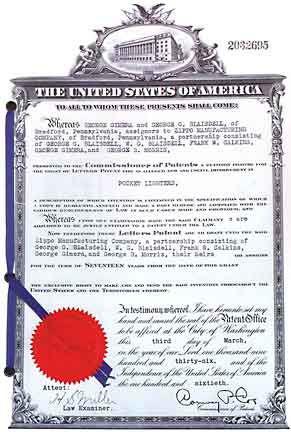
One of the first acts Bleysdella in promoting their goods became mailings to addresses of shops, bars and clubs handbill, which was represented as a Zippo lighter is the most reliable operating in all weather conditions. It buyers Zippo proposes to her so-called "fentestu." He lay in the fact that the Zippo ignited at a distance of not more than three feet from the included blower motor (hair dryer). If within a week once she did not fire, the buyer was free to return it to the seller and get your money back. Recall that the price of Zippo at that time was only $ 1.95. The same procedure was proposed to perform with other lighters, and see the benefits of Zippo.
This idea has already received in 1937 continued in the first big Zippo advertisement in a national magazine for men "Esquire» (Esquire). Bleysdell took the money and bought for $ 3,000 a whole page of the magazine, in which he placed a text ad for lighter windproof properties (windproof lighter), its lifetime warranty (lifetime guarantee) and variations of models (by that time there have been several models with an engraved Zippo). On page was painted a pretty girl lights a Zippo in the wind. The inscription below the image reads: "She went Feng test." This announcement is considered a historical as well as after its publication for Zippo entrenched term "windproof" lighters and thanks to animate many men began to consider her his "good friend." However, prior to this event creator Zippo Bleysdell not have the means for expensive advertising, and he came up with the next move ...
Recalling his school friend who owned a garage in Bradford coaches, Bleysdell asked him to distribute his lighter bus drivers so that they demonstrated their passengers wind-proof quality. The fee for this type of advertising drivers should get lighter for personal use free of charge. It was a brilliant cost-free advertising for the first time the extensions popularity Zippo outside Bradford.
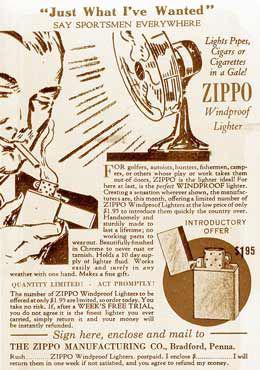
Lot of trouble Mister Zippo, trying to reach the "personalization" of their offspring. A year after the start of production of lighters he began to decorate their prints and drawings by enamel. First it was simple models Zippo with a picture of a drunkard, head of a dog or a horse. Then Bleysdell became engrave personal monograms and logos. The colors and shape monograms constantly varied, but the extra charge for this kind of work remain unchanged: only $ 1.00. Advertising slogans for these products were selected Bleysdellom, as always, very well: "A gift that is always with you" or "gift that comes to mind as many times as you light your Zippo».
The decisive moment in the personalization Zippo came in 1936, when the oil company "Kendall Oil» (Kendall Oil), supplying Bleysdellu kerosene to fuel lighters, Zippo has ordered 500 with its logo. Since then and to this day Zippo successfully developed a prestigious area of production of lighters as a work of art. And in the next, 1937, year of financial success Zippo, resulting from a talented advertising company Bleysdella allowed him to start producing so-called "sports series." On the bodies of lighters depicted hunter, fisherman, golfer, sports yacht, skier, baseball player, that is, subjects related to outdoor sports. This was achieved by linking "windproof» Zippo with wildlife.
And finally, in the prewar years, Mister Zippo had another successful advertising campaign, which enabled him to realize more than 300 thousand lighters. In those days, in the bars and cafes has been extended (albeit illegally) a simple game called "panchbord» (punchboard). On the wall hung the board with one or two thousand holes sealed paper. All holes were numbered paper in random order. In the upper part of the board were written winning numbers. Any visitor for just 2 cents could poke a pencil in one of the holes and, if the number of open holes are lined up with the number at the top of the board, got lucky prize - the lighter Zippo. Thanks to "panchbordu" Zippo became popular all-American. And then there was the Second World War. And the popularity of Zippo crossed the borders of the United States.
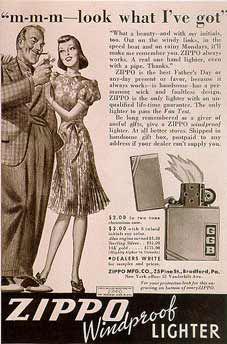
During the Second World War, many US products have become world famous. Among them razor Gillette, watch Hamilton, cars Jeep, Hershey's chocolate and, of course, lighters Zippo.
The company Zippo MFG, is not an official supplier of goods for the army, but the popularity of its lighters was so great that from the first days of the war Bleysdell Zippo supplied hundreds in the army and navy supply points. Soldiers and sailors attracted Zippo reliability is well protected from wind and moisture, and low cost.
Zippo World War II differed from their predecessors externally, because, due to difficulties with raw materials, their hulls were made of porous steel instead of nickel-plated brass. Their surface was rough and blackens. They looked a bit clumsy, but it is better kept in the palm of your hand and glittered than respected blackout. Body could rust, but the mechanism is still worked perfectly. However, Bleysdell, with his characteristic pedantry, is applied to each lighter leaflet which apologized for the change in its appearance, caused by extraordinary circumstances.
On the war front Zippo acquired its new functions. It was used not only to light a cigarette, but also to fuel fires for supplying various signals, for warming the frozen hands, even to warm soup in helmets.
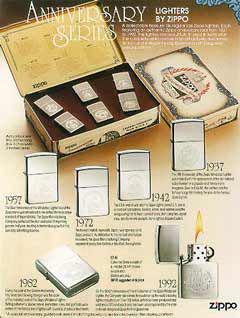
There are cases when Zippo saved the life of her owners and their companions. Once a group of sailors from the sunken ship drifted on a small raft all day, and when night fell, one of the sailors lit his lighter as a signal for help. She saw the light from a passing boat and the sailors were rescued. Another case involved a crew dive bomber as he was returning to base after a combat mission. Suddenly refused to board lighting and since it was late at night, the navigator could not correctly identify the direction of flight of the darkened devices. Helped the crew to land safely at its base light lighters Zippo. Among the Marines were many cases where Zippo, position in the breast pocket of his jacket, took over an enemy bullet and saved the life of the host. Stories related to Zippo, passed from mouth to mouth, and at the same time with its remarkable qualities, strengthened its reputation on the front and rear. It became known as "the soldier's best friend." On the hulls of lighter steel scratching names, initials, slogans, they were decorated with emblems, coins and even models. Zippo popularity among the military has led to the fact that in 1942 the company Bleysdella only worked for the army. Zippo, almost impossible to buy in the US in a regular store or bar. Among the population at that time was also disseminated a statement: "We are here at home, we can only dream about to ignite in the wind one thumb his Zippo». But the war was over and, together with the return to civilian life, to his admirers back and Zippo.
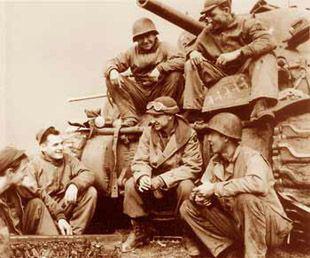
Zippo military has long played a special role as virtually the only source of heat and ignition in the harshest conditions of military service. She was a mandatory attribute of the long-awaited "smoke breaks" and performs a number of additional functions as a pocket mirror, signal light, mini torch, etc. Soldiers in the US Army almost completely equipped by the state, for which he received the nickname GI (CI - Government Issue). Zippo, despite its obvious utility was not included in the list of state-owned items and buy soldiers in army stores for their own money. This distinguishes it from other ammunition and gave rise to her special relationship with the soldiers.
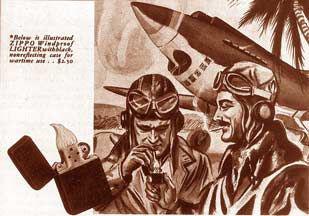
During the Vietnam War, the inscriptions and decorations on Zippo, became the rage phenomenon. Soldiers who are in this hellish slaughter under constant threat of death, tried to capture on unpretentious lighters state of his soul and pursuing their thoughts. Therefore Zippo since Vietnam today is an interesting subject for collectibles. They can be found clumsily scrawled a simple soldier's knife line, curse war and heavy soldier's share. There are made by skilled engravers South Vietnamese figures, names and dates of the most brutal battles, maps of Vietnam, personal messages. Many are decorated with emblems of military units and various figures.
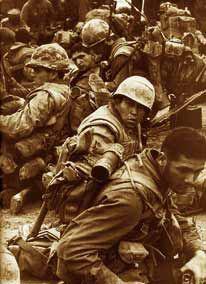
A special place in Zippo lighters since Vietnam occupy the US Navy sailors who participated in the battles of the river in the Mekong Delta. Depicted on them warships and naval units emblems differ a special quality and the art of engraving. In general, the relationship with the US Army Zippo MFG.Co the time of the Vietnam War has become a long-standing and close cooperation. Back in the 40s the company began producing lighters with logos of arms and military subjects. By the 60th the same year, almost every military unit to place orders for Zippo with a picture of their markings and the number of Zippo military logos reached several thousand. Often themselves logo design department developed Zippo MFG.Co.
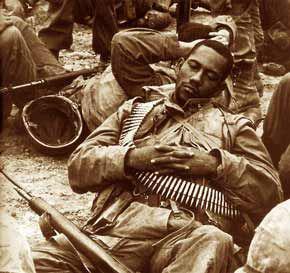
Particularly popular Zippo acquired in the Navy. Each warship consider it my duty to have their own supply of lighters with your logo or a picture of the ship that were issued to each member of the crew on the memory at the end of life. In the property of soldiers, sailors and airmen took place Zippo along with compulsory subjects such as a knife, a spoon, a belt, helmet, cape. Moreover, in addition to its practical features, it serves as a reliable friend and mascot. A Zippo, made on special order with symbols of regiments, divisions, batteries, squadrons, ships, squadrons became the hallmark of these compounds, to strengthen the spirit of unity and camaraderie among veterans and new recruits.
The uniqueness of the images on lighters, their difficult destiny and important role in the harsh military service makes military Zippo special souvenirs for their owners and desirable for collectors.
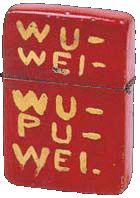
Continuing the mass production of traditional pocket lighters, the company began to expand its product range. In the early '50s were produced several series of elegant desktop lighters, mechanical part of which remained unchanged, retaining its crown of quality: reliability, windproof and easy to handle. By the same type of external adds a special refinement and elegance.
For women were released model Lady Bradford and Corinthian. Men are more suitable Bancroft and Moderne. Soon the product range of the company Zippo MFG. Become replenished items not related to lighters. Now set the agent Zippo attended trinkets, pocket knives, golf balls, pens, various buckles and clippers. At the same time, the company continued to actively release advertising Zippo.
Since 1956, for the application of the engraving on the body of Zippo has been applied by chemical etching of the metal. This made it possible to complicate the picture, to make it more detailed and multi-colored. Advertising Zippo become like artist's canvas. Some of them were real works of art. Many companies soon realized that the Zippo is an ideal permanent advertising in the pocket of each consumer. For the very same Zippo MFG Company promotional products not only bring tangible revenues, but also contributed to the consolidation in the consumer's mind the image of Zippo as integral part of American life. That is why a special place in the advertising policy of the company was given to cooperation with companies that are represented by such "American reality", as Coca-Cola, PANAM, aircraft Lockhead, Boeing, razor Gillette.
However, the most successful has been working with tobacco corporations. In the late 50's Philip Morris used a Zippo with unchanged cowboys and horses in their large-scale advertising campaign. Since then, Zippo and Marlboro - are inseparable. Shortly advertising Zippo already given more than 40% of all revenues. And together with the expansion of their production is becoming increasingly important colorful Zippo, as collectibles.
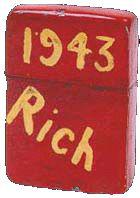
This family Zippo, begun in the postwar years, the so-called sports series, eventually identified as a new product group Zippo and now brings the most stable revenue. Thanks to the ingenuity and endless imagination of designers Zippo about 70-80% of all lighters are bought as a gift. And they do not necessarily give smoking people. For many Zippo - it is a piece of art and collectibles. And some just do not see stories collectible Zippo! That only is a series of NASA, dedicated to space flight. Or military series, where you can find almost every connection emblem of the US Army.
A variety of sports series meet not only the logo and lettering, but real portraits of famous athletes. Zippo with inlay, Zippo camouflage, Zippo mirror, Zippo copper, brass, silver, gold, etc.
At home Zippo in Bradford (Pennsylvania) is an extensive museum Zippo, which contains all kinds of lighters different time destinies. There are halls of experimental models, prototypes Zippo, broken and repaired Zippo, a masterpiece of design and legendary Zippo, Zippo collection and modern developments.
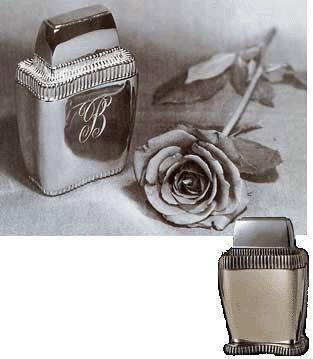
From his youth he had an affair with metal and machinery and has a great desire to invent. Dancing and empty talk about politics soon tired of George, and he went out to smoke on the porch of the club, where he found his friend Dick Dresser, puffing in an attempt to remove the cover with his old and battered Austrian lighter. Dick was quite a wealthy man, and George allowed himself to remark: "Why do not you buy more presentable lighter?" Dick finally pulled off the lid and struck a wheel. Despite the relatively strong wind, lighter lit, and Dick lit his cigarette. "Because it works!" - Dick grunted in response to the question, George. At this point, George thought occurred: "Lighter! Here's what you need to constantly person regardless of his material situation! "Since then, the head of George was filled with the idea of producing reliable lighters accessible to everyone.

He began by saying that he had received an exclusive license to import Austrian lighters in the US and bought a small lot for sale. Unable to sell any, he found some defects in them and decided to create his unfading lighter. Rent a small room in the building metalloremontnyh workshops, he filled his second-hand machines, hired three locksmiths, and work has begun to boil.

First Bleysdell reduce the size of the lighter so that it fits in your palm. He then, remembering the suffering of others, Dick, combined with the housing cover loop. Now you can open and zapalivat lighter in one hand. Windscreen around the wick he left unchanged, keeping even the same number of holes, was found in the Austrian ancestor. Slightly improved wheel and flint. Petrol was poured directly into the body, which is of a simple brass became chrome.
So, the new product was ready. He received the name «Zippo». Origin of the name is also very uncomplicated. Around the same time, the US was invented solid sliding metal clasp, we have received the name "Lightning", and at home - "Zipper". Bleysdellu liked the sound of the word "zipper" and he decided to call his work in tune with him.
The price of the new "windproof" lighters was $ 1.95. In the first month it sold 82 pieces. The case has gone. Reliability, convenience and affordable price Zippo quickly won her popularity, but still a major advantage Zippo was trading company policy, as expressed in almost perpetual guarantee of its products. Engineer Bleysdell so loved his child that swore that looks Zippo not be replaced while he lived.
But after his death Lighter virtually retained their form. However, some models have become more refined, richer and more colorful. But the highest reliability, achieved already at the beginning, remained unchanged. No wonder the museum in Bradford Zippo lighters are kept of all time, since the release of 1932. And all the work!
Continuing the theme of the history of the world-famous cigarette lighters, you can not miss the story of advertising talent of their creator - "Mr. Zippo", namely the so began to call an engineer Bleysdella already since the release of the first batch of lighters.

One of the first acts Bleysdella in promoting their goods became mailings to addresses of shops, bars and clubs handbill, which was represented as a Zippo lighter is the most reliable operating in all weather conditions. It buyers Zippo proposes to her so-called "fentestu." He lay in the fact that the Zippo ignited at a distance of not more than three feet from the included blower motor (hair dryer). If within a week once she did not fire, the buyer was free to return it to the seller and get your money back. Recall that the price of Zippo at that time was only $ 1.95. The same procedure was proposed to perform with other lighters, and see the benefits of Zippo.
This idea has already received in 1937 continued in the first big Zippo advertisement in a national magazine for men "Esquire» (Esquire). Bleysdell took the money and bought for $ 3,000 a whole page of the magazine, in which he placed a text ad for lighter windproof properties (windproof lighter), its lifetime warranty (lifetime guarantee) and variations of models (by that time there have been several models with an engraved Zippo). On page was painted a pretty girl lights a Zippo in the wind. The inscription below the image reads: "She went Feng test." This announcement is considered a historical as well as after its publication for Zippo entrenched term "windproof" lighters and thanks to animate many men began to consider her his "good friend." However, prior to this event creator Zippo Bleysdell not have the means for expensive advertising, and he came up with the next move ...
Recalling his school friend who owned a garage in Bradford coaches, Bleysdell asked him to distribute his lighter bus drivers so that they demonstrated their passengers wind-proof quality. The fee for this type of advertising drivers should get lighter for personal use free of charge. It was a brilliant cost-free advertising for the first time the extensions popularity Zippo outside Bradford.

Lot of trouble Mister Zippo, trying to reach the "personalization" of their offspring. A year after the start of production of lighters he began to decorate their prints and drawings by enamel. First it was simple models Zippo with a picture of a drunkard, head of a dog or a horse. Then Bleysdell became engrave personal monograms and logos. The colors and shape monograms constantly varied, but the extra charge for this kind of work remain unchanged: only $ 1.00. Advertising slogans for these products were selected Bleysdellom, as always, very well: "A gift that is always with you" or "gift that comes to mind as many times as you light your Zippo».
The decisive moment in the personalization Zippo came in 1936, when the oil company "Kendall Oil» (Kendall Oil), supplying Bleysdellu kerosene to fuel lighters, Zippo has ordered 500 with its logo. Since then and to this day Zippo successfully developed a prestigious area of production of lighters as a work of art. And in the next, 1937, year of financial success Zippo, resulting from a talented advertising company Bleysdella allowed him to start producing so-called "sports series." On the bodies of lighters depicted hunter, fisherman, golfer, sports yacht, skier, baseball player, that is, subjects related to outdoor sports. This was achieved by linking "windproof» Zippo with wildlife.
And finally, in the prewar years, Mister Zippo had another successful advertising campaign, which enabled him to realize more than 300 thousand lighters. In those days, in the bars and cafes has been extended (albeit illegally) a simple game called "panchbord» (punchboard). On the wall hung the board with one or two thousand holes sealed paper. All holes were numbered paper in random order. In the upper part of the board were written winning numbers. Any visitor for just 2 cents could poke a pencil in one of the holes and, if the number of open holes are lined up with the number at the top of the board, got lucky prize - the lighter Zippo. Thanks to "panchbordu" Zippo became popular all-American. And then there was the Second World War. And the popularity of Zippo crossed the borders of the United States.

During the Second World War, many US products have become world famous. Among them razor Gillette, watch Hamilton, cars Jeep, Hershey's chocolate and, of course, lighters Zippo.
The company Zippo MFG, is not an official supplier of goods for the army, but the popularity of its lighters was so great that from the first days of the war Bleysdell Zippo supplied hundreds in the army and navy supply points. Soldiers and sailors attracted Zippo reliability is well protected from wind and moisture, and low cost.
Zippo World War II differed from their predecessors externally, because, due to difficulties with raw materials, their hulls were made of porous steel instead of nickel-plated brass. Their surface was rough and blackens. They looked a bit clumsy, but it is better kept in the palm of your hand and glittered than respected blackout. Body could rust, but the mechanism is still worked perfectly. However, Bleysdell, with his characteristic pedantry, is applied to each lighter leaflet which apologized for the change in its appearance, caused by extraordinary circumstances.
On the war front Zippo acquired its new functions. It was used not only to light a cigarette, but also to fuel fires for supplying various signals, for warming the frozen hands, even to warm soup in helmets.

There are cases when Zippo saved the life of her owners and their companions. Once a group of sailors from the sunken ship drifted on a small raft all day, and when night fell, one of the sailors lit his lighter as a signal for help. She saw the light from a passing boat and the sailors were rescued. Another case involved a crew dive bomber as he was returning to base after a combat mission. Suddenly refused to board lighting and since it was late at night, the navigator could not correctly identify the direction of flight of the darkened devices. Helped the crew to land safely at its base light lighters Zippo. Among the Marines were many cases where Zippo, position in the breast pocket of his jacket, took over an enemy bullet and saved the life of the host. Stories related to Zippo, passed from mouth to mouth, and at the same time with its remarkable qualities, strengthened its reputation on the front and rear. It became known as "the soldier's best friend." On the hulls of lighter steel scratching names, initials, slogans, they were decorated with emblems, coins and even models. Zippo popularity among the military has led to the fact that in 1942 the company Bleysdella only worked for the army. Zippo, almost impossible to buy in the US in a regular store or bar. Among the population at that time was also disseminated a statement: "We are here at home, we can only dream about to ignite in the wind one thumb his Zippo». But the war was over and, together with the return to civilian life, to his admirers back and Zippo.

Zippo military has long played a special role as virtually the only source of heat and ignition in the harshest conditions of military service. She was a mandatory attribute of the long-awaited "smoke breaks" and performs a number of additional functions as a pocket mirror, signal light, mini torch, etc. Soldiers in the US Army almost completely equipped by the state, for which he received the nickname GI (CI - Government Issue). Zippo, despite its obvious utility was not included in the list of state-owned items and buy soldiers in army stores for their own money. This distinguishes it from other ammunition and gave rise to her special relationship with the soldiers.

During the Vietnam War, the inscriptions and decorations on Zippo, became the rage phenomenon. Soldiers who are in this hellish slaughter under constant threat of death, tried to capture on unpretentious lighters state of his soul and pursuing their thoughts. Therefore Zippo since Vietnam today is an interesting subject for collectibles. They can be found clumsily scrawled a simple soldier's knife line, curse war and heavy soldier's share. There are made by skilled engravers South Vietnamese figures, names and dates of the most brutal battles, maps of Vietnam, personal messages. Many are decorated with emblems of military units and various figures.

A special place in Zippo lighters since Vietnam occupy the US Navy sailors who participated in the battles of the river in the Mekong Delta. Depicted on them warships and naval units emblems differ a special quality and the art of engraving. In general, the relationship with the US Army Zippo MFG.Co the time of the Vietnam War has become a long-standing and close cooperation. Back in the 40s the company began producing lighters with logos of arms and military subjects. By the 60th the same year, almost every military unit to place orders for Zippo with a picture of their markings and the number of Zippo military logos reached several thousand. Often themselves logo design department developed Zippo MFG.Co.

Particularly popular Zippo acquired in the Navy. Each warship consider it my duty to have their own supply of lighters with your logo or a picture of the ship that were issued to each member of the crew on the memory at the end of life. In the property of soldiers, sailors and airmen took place Zippo along with compulsory subjects such as a knife, a spoon, a belt, helmet, cape. Moreover, in addition to its practical features, it serves as a reliable friend and mascot. A Zippo, made on special order with symbols of regiments, divisions, batteries, squadrons, ships, squadrons became the hallmark of these compounds, to strengthen the spirit of unity and camaraderie among veterans and new recruits.
The uniqueness of the images on lighters, their difficult destiny and important role in the harsh military service makes military Zippo special souvenirs for their owners and desirable for collectors.

Continuing the mass production of traditional pocket lighters, the company began to expand its product range. In the early '50s were produced several series of elegant desktop lighters, mechanical part of which remained unchanged, retaining its crown of quality: reliability, windproof and easy to handle. By the same type of external adds a special refinement and elegance.
For women were released model Lady Bradford and Corinthian. Men are more suitable Bancroft and Moderne. Soon the product range of the company Zippo MFG. Become replenished items not related to lighters. Now set the agent Zippo attended trinkets, pocket knives, golf balls, pens, various buckles and clippers. At the same time, the company continued to actively release advertising Zippo.
Since 1956, for the application of the engraving on the body of Zippo has been applied by chemical etching of the metal. This made it possible to complicate the picture, to make it more detailed and multi-colored. Advertising Zippo become like artist's canvas. Some of them were real works of art. Many companies soon realized that the Zippo is an ideal permanent advertising in the pocket of each consumer. For the very same Zippo MFG Company promotional products not only bring tangible revenues, but also contributed to the consolidation in the consumer's mind the image of Zippo as integral part of American life. That is why a special place in the advertising policy of the company was given to cooperation with companies that are represented by such "American reality", as Coca-Cola, PANAM, aircraft Lockhead, Boeing, razor Gillette.
However, the most successful has been working with tobacco corporations. In the late 50's Philip Morris used a Zippo with unchanged cowboys and horses in their large-scale advertising campaign. Since then, Zippo and Marlboro - are inseparable. Shortly advertising Zippo already given more than 40% of all revenues. And together with the expansion of their production is becoming increasingly important colorful Zippo, as collectibles.

This family Zippo, begun in the postwar years, the so-called sports series, eventually identified as a new product group Zippo and now brings the most stable revenue. Thanks to the ingenuity and endless imagination of designers Zippo about 70-80% of all lighters are bought as a gift. And they do not necessarily give smoking people. For many Zippo - it is a piece of art and collectibles. And some just do not see stories collectible Zippo! That only is a series of NASA, dedicated to space flight. Or military series, where you can find almost every connection emblem of the US Army.
A variety of sports series meet not only the logo and lettering, but real portraits of famous athletes. Zippo with inlay, Zippo camouflage, Zippo mirror, Zippo copper, brass, silver, gold, etc.
At home Zippo in Bradford (Pennsylvania) is an extensive museum Zippo, which contains all kinds of lighters different time destinies. There are halls of experimental models, prototypes Zippo, broken and repaired Zippo, a masterpiece of design and legendary Zippo, Zippo collection and modern developments.



